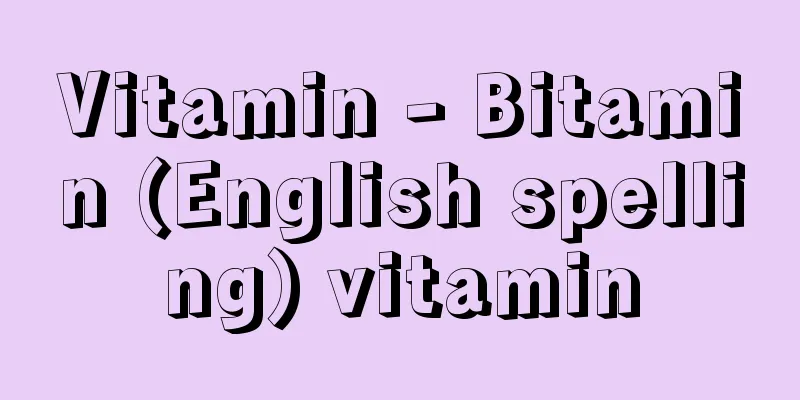Vitamin - Bitamin (English spelling) vitamin

|
A group of organic substances found in small amounts in natural foods. Vitamins are included in the five major nutrients along with lipids, carbohydrates, proteins, and minerals. They are essential for normal metabolism, and if they are lacking in the food we eat, deficiency diseases occur. Many vitamins function as coenzymes in the body, controlling or regulating metabolism in small amounts, but they do not themselves become energy sources or components of the body, and are not synthesized in the body, so they must be ingested from the outside world through food. However, some vitamins, such as nicotinic acid, are partially synthesized in the liver but do not reach the required amount. In addition, there are differences in metabolic systems between animals. For example, vitamin C (ascorbic acid), which is necessary for the hydroxylation of proline residues in collagen, is synthesized in the body from glucose in many animals, but humans and monkeys do not have this biosynthetic pathway and are not produced. Therefore, vitamin C is not a vitamin in many animals, but it is a vitamin for humans and monkeys. In addition, inorganic substances (minerals) are micronutrients like vitamins, but they are not organic compounds, and hormones have the same function as vitamins but are produced in the body (by endocrine glands), so they are distinguished from vitamins. [Teruyoshi Arima, Taro Arima, and Tamiyo Takeuchi] nameVitamins were first named alphabetically according to the year of discovery, A, B, C, etc., and further subdivided by numbers such as B1 , B2 , etc., but when the chemical structure of each was revealed, precise chemical names or substance names (compound names) were proposed to represent the structure, and currently vitamin names and compound names are used in combination. Many discovered vitamins were named after their functions, such as vitamin L, which was named after lactation, the secretion of milk. There are no vitamins B3 or B4 , because after their discovery and reporting, it was discovered that B3 is the same as pantothenic acid, and B4 is a mixture of amino acids such as arginine and cystine, and they were excluded because they did not fit the definition of vitamins. Also, some of the things discovered and reported as vitamins were found to be inappropriate in subsequent research, and those with clear physiological significance are treated as vitamin-like factors. These include vitamin F (essential fatty acids), vitamin Q (ubiquinone), vitamin N (α-lipoic acid, also known as thioctic acid), vitamin B T (carnitine), vitamin B 13 (orotic acid), vitamin B X (para-aminobenzoic acid), vitamin P (flavonoids such as rutin), and vitamin U (methylmethionine sulfonium chloride). In addition, some foods contain vitamin precursors that are converted into vitamins in the body and exert their effects. These are collectively called provitamins. These include provitamin A (carotene) and provitamin D (ergosterol). [Teruyoshi Arima, Taro Arima, and Tamiyo Takeuchi] kindsVitamins are organic molecules that some higher animals need to ingest in small amounts in their diet. These molecules play roughly the same role in all living organisms, but higher animals have lost the ability to synthesize them. There are many types of vitamins, each with a different chemical structure and function, making it difficult to strictly classify them, but they are generally classified according to whether they are water-soluble or fat-soluble, and whether they are easily soluble in non-polar (organic) solvents. [Teruyoshi Arima, Taro Arima, and Tamiyo Takeuchi] Water-soluble vitaminsMost water-soluble vitamins are components of coenzymes, such as ascorbic acid (vitamin C) and the B vitamins known as the B complex. The B vitamins are derivatives (precursors or building blocks) of coenzymes. The ionized form of ascorbic acid, called ascorbate, acts as a reducing agent (antioxidant). The importance of ascorbic acid is well known in scurvy, where it is necessary for the hydroxylation of proline residues to maintain the triple helix structure of collagen, the main protein of connective tissue. Water-soluble vitamins play catalytic roles in the body as follows: Vitamin B1 (thiamine) → thiamine pyrophosphate Vitamin B2 (riboflavin) → flavin adenine dinucleotide (FAD) Fat-soluble vitaminsFat-soluble vitamins are involved in a variety of processes, including blood clotting and vision. They include vitamins A, D, E, and K. Vitamin A (retinol in the narrow sense) is metabolized in the body through two steps of oxidation to retinal (the visual pigment) and retinoic acid. It is also the precursor of retinal, the light-sensitive group in rhodopsin and other visual pigments, and its deficiency causes night blindness. Furthermore, young animals require vitamin A for growth. Retinoic acid, which is biosynthesized from vitamin A in the body, has a carboxylic acid instead of the terminal alcohol of retinol and activates the transcription of certain genes that mediate development and growth. Many of the components of the signaling pathway through which retinoic acid acts are present in the brain. Retinoic acid is known to play a role in sleep, learning, and memory, but the exact mechanism is unknown. Calcium and phosphorus metabolism are regulated by hormones derived from vitamin D. Vitamin D deficiency in growing animals impairs bone formation. Vitamin D protects unsaturated membrane lipids from oxidation. Vitamin K (from the German word Koagulation, meaning coagulation) is required for normal blood clotting and is involved in the carboxylation of glutamic acid residues to form gamma-carboxyglutamic acid, which converts this group into a potent chelator of calcium ions (Ca2 + ). [Teruyoshi Arima, Taro Arima, and Tamiyo Takeuchi] Mechanism of actionWhen vitamins were first discovered, they were mysterious entities that performed important functions in minute amounts, but since then, the chemical structures of many vitamins have been determined, they can be synthesized, and their mechanisms of action have been clarified. In particular, it has become clear that they act as catalysts in the body as components of coenzymes, including the B vitamins. For example, when pyruvate becomes acetyl coenzyme A, vitamins such as vitamin B1 (thiamine), vitamin B2 (riboflavin), niacin, vitamin B5 (pantothenic acid), and vitamin N (α-lipoic acid) act as catalysts, and vitamin B2 and pantothenic acid are involved in the pathway from fatty acids to acetyl coenzyme A, while vitamins B2 , B6 , and niacin are also involved in the decomposition of amino acids, and vitamin B1 is involved as a component of the coenzymes in the pentose phosphate cycle. Although vitamin C does not function as a coenzyme, its strong reducing action has been shown to be related to the action of enzymes. Vitamin D has no biological activity by itself, but becomes active when oxidized in the body, and acts not like a vitamin in the classical sense, but like a hormone, exerting its effect on distant target organs such as the intestine and bones, and its mode of transport and mechanism of action in the blood and within cells are exactly the same as those of steroid hormones, so it has come to be considered a hormone-like substance. [Teruyoshi Arima, Taro Arima, and Tamiyo Takeuchi] Absorption and ExcretionVitamins are usually ingested orally as part of food and enter the digestive tract. They are absorbed mainly through the small intestine and reach the cells in the body along with the blood, where they become active substances such as enzymes and are involved in metabolism, and are then excreted in the urine. However, there are significant differences between water-soluble and fat-soluble vitamins. Water-soluble vitamins, especially B vitamins, are often absorbed by active transport, and the required amount is absorbed very efficiently. However, when large amounts are given orally as medication, the capacity of active transport is exceeded, and the absorption rate drops. In addition, many of the absorbed water-soluble vitamins act as enzymes, and even if a large amount is given at once by injection, any vitamins that are more than what binds to the apoenzymes are excreted in the urine. Therefore, it is necessary to take the required amount of water-soluble vitamins orally every day. Only vitamin B12 is stored in the liver. Fat-soluble vitamins are absorbed together with fat from the digestive tract. In other words, absorption is poor if there is not a certain amount of fat. Vitamin A in animal foods is well absorbed, but provitamin A in plant foods is very poorly absorbed as is. Therefore, in the latter case, cooking with fats and oils is necessary. In addition, pancreatic juice and bile are necessary for fat absorption, and in cases of pancreatic disease or liver disease (especially obstructive jaundice), fat absorption is impaired and absorption of fat-soluble vitamins is poor. Absorbed fat-soluble vitamins are stored in the liver (vitamins A, D, and K) or adipose tissue (vitamin E) and are transported by lipoproteins or specific binding proteins, but are not excreted in the urine but in the bile. They can also accumulate in the body and cause excess disease. [Teruyoshi Arima, Taro Arima, and Tamiyo Takeuchi] Dietary Reference IntakesIn Japan, the dietary reference intakes for vitamins were traditionally established from the perspective of preventing deficiencies, but in recent years, the Ministry of Health, Labor and Welfare has established water-soluble vitamins (vitamins B1 , B2 , B6, B12 , niacin, pantothenic acid, biotin, folic acid, vitamin C) and fat-soluble vitamins (vitamins A, D, E, K) for the purpose of maintaining and promoting health , preventing lifestyle-related diseases, and preventing health disorders due to excessive intake. These are known to cause deficiencies in humans, and their required amounts have been revised every five years since their establishment in 1970 (Showa 45), but in 2005 (Heisei 17), they were revised from the previous required amounts to dietary reference intakes. Estimated average requirement (EAR), recommended dietary allowance (RDA), and tolerable upper intake level (UL) have been set, but for vitamins that are difficult to set, adequate intake (AI) has been indicated. The EAR for a vitamin is an estimate of the average requirement for Japanese people by sex and age group based on the minimum requirement determined by restriction tests, and is the daily intake amount that is estimated to meet the requirement of 50% of the group. The RDA is the amount that is estimated to meet the daily requirement of most of the group (97-98%) and is calculated by adding twice the standard deviation (SD) of individual differences (2SD) to the EAR. The AI is the amount sufficient for the group to maintain good nutritional status, and is used for pantothenic acid, biotin, and vitamins E, D, and K. The UL is the maximum amount at which excessive intake will not cause health problems, and has been set for vitamin B6 , niacin, folic acid, and vitamins A, D, and K. [Teruyoshi Arima, Taro Arima, and Tamiyo Takeuchi] Related illnessesVitamins are essential nutrients, and if they are not ingested in the form of food, they cause deficiency symptoms. This is called vitamin deficiency, and general symptoms include growth retardation and weight loss, but other specific symptoms such as those listed below may also appear. Deficiencies that occur when a vitamin cannot be used properly in the body for some reason are called secondary vitamin deficiencies, and the vitamins that cause these are vitamins A, D, B2 , and nicotinic acid. These can be cured or prevented by administering the specific vitamin. Water-soluble vitamin deficiency Vitamin B1 : Beriberi, axial optic neuritis, polyneuritis, Wernicke's encephalopathy Vitamin B2 : Angular stomatitis, cheilitis, glossitis, seborrheic dermatitis, diffuse superficial keratitis Niacin: Pellagra Folic acid: Anemia Vitamin B12 : Pernicious anemia Vitamin C: Scurvy Fat-soluble vitamin deficiency Vitamin A: Night blindness, dry eye, keratomalacia, follicular keratosis Vitamin D: Rickets, osteomalacia, osteoporosis, developmental disorders of bones and teeth Vitamin E: Infertility, motor dysfunction Vitamin K: Blood coagulation disorder, liver disorder, neonatal melena (neonatal bleeding) Fat-soluble vitamin hypervitaminosis Vitamin A: increased brain pressure, pain and swelling in the limbs, liver damage Vitamin D: hypercalcemia, kidney damage There are diseases in which, even though there is no physiological vitamin deficiency, health cannot be maintained unless large amounts of vitamins, several to several hundred times the normal amount, are administered due to genetic defects, and these are called vitamin addictions. These include addictions to vitamins B1 , B6 , B12 , and D, as well as folic acid and biotin. [Teruyoshi Arima, Taro Arima, and Tamiyo Takeuchi] Major VitaminsMore than twenty kinds of vitamins have been discovered so far, but some are not so certain. Below, we will briefly explain the main vitamins (fat-soluble vitamins and water-soluble vitamins). [Teruyoshi Arima, Taro Arima, and Tamiyo Takeuchi] Vitamin AIt includes retinol (vitamin A 1 ), dehydroretinol (vitamin A 2 ), and their derivatives, but in the narrow sense it refers to retinol. It is easily decomposed by acid, air, and light, but is relatively stable in alkaline conditions. Vitamin A is known to be involved in maintaining functions such as vision, hearing, and reproduction, promoting growth, maintaining normal epithelial tissues such as the skin and mucous membranes, differentiation mechanisms, anti-cancer (cancer) through gene expression, and protein synthesis. Vitamin A deficiency can cause dry skin and keratinization, as well as dry conjunctiva and softening of the cornea, and early deterioration of vision in twilight and dark places, leading to night blindness. Night blindness is caused by damage to the optic rhodopsin in the rods of the retina. Rhodopsin is a combination of vitamin A aldehyde (retinal) and protein, and vitamin A deficiency inhibits the synthesis and regeneration of rhodopsin, resulting in night blindness. Provitamin A (β-carotene) becomes vitamin A in the intestinal mucosa and is stored as an ester in the liver. The yield of β-carotene when it is converted to retinol in the body is half by mass, and its digestive absorption rate is one-third that of retinol, so when vitamin A is ingested in the form of β-carotene, six times the required amount is required. Ingestion of large amounts of vitamin A can cause overdose, which can be divided into acute poisoning, which is characterized by increased intracranial pressure and is common in infants, and chronic poisoning, which is characterized by painful swelling of the limbs and is seen when taken over a long period of time (one to several months). [Teruyoshi Arima, Taro Arima, and Tamiyo Takeuchi] Vitamin DAlso called calciferol. Six types of vitamin D are known, from 2 to 7. Of these, only two types, vitamin D 2 (ergocalciferol) and D 3 (cholecalciferol), show high biological activity and are used in practical applications. The provitamin Ds ergosterol (provitamin D 2 ) and 7-dehydrocholesterol (provitamin D 3 ) are widely distributed in the animal and plant kingdoms. When exposed to ultraviolet light, ergocalciferol (vitamin D 2 ) is produced from ergosterol in plants, and cholecalciferol (vitamin D 3 ) is produced from 7-dehydrocholesterol in animals. Both vitamin D 2 and D 3 have the same biological activity as vitamin D. Vitamin D 1 is a mixture with vitamin D 2 as the main component. The activation of vitamin D is affected by parathyroid hormone, blood phosphate concentration, and the concentration of vitamin D itself, and promotes calcium absorption in the small intestine and resorption from the kidneys and bones. Rickets has long been known as a deficiency disease, while excess vitamin D is seen when large amounts of vitamin D are administered over a long period of time to prevent or treat rickets, causing severe systemic symptoms (hypercalcemia), primarily kidney damage. [Teruyoshi Arima, Taro Arima, and Tamiyo Takeuchi] Vitamin EThere are eight known naturally occurring vitamin E-active substances: four tocopherols (α, β, γ, δ (delta)) and four tocotrienols (α, β, γ, δ). The collective name for these is vitamin E. α-tocopherol has the strongest biological activity, and in the narrow sense, this refers to it. Vitamin E is widely distributed in the animal and plant kingdoms, and is distributed in all tissues within the animal body. Although much is still unknown about the mechanism of action of vitamin E, it is known to have a nonspecific antioxidant effect. That is, it is absorbed from the digestive tract and accumulated in various organs and fats in the body, preventing the oxidation of unsaturated fatty acids. In addition, the consumption of vitamin E increases with increased intake of highly unsaturated fatty acids, so supplementation is necessary. Although there have been many reports of deficiency in experimental animals such as mice, complete deficiency has not yet been reported in humans, and only a slight decrease in the antioxidant effect in biological membranes due to vitamin E deficiency has been recognized as one of the causes of anemia seen in premature infants and kwashiorkor (severe malnutrition in infants caused by protein deficiency). As for excess, no adverse effects have yet been observed in experimental animals. [Teruyoshi Arima, Taro Arima, and Tamiyo Takeuchi] Vitamin KVitamin K activators that primarily promote blood clotting include vitamin K 1 (phylloquinone), found in green leaves, vitamin K 2 (menaquinone), produced by bacteria, and vitamin K 3 (menadione), which are synthetic products. Many congeners have been isolated or synthesized, all of which are naphthoquinone derivatives. Vitamin K is also known as an antihemorrhagic vitamin because it promotes the production of blood clotting factors such as prothrombin and maintains normal blood clotting function. Vitamin K is widely present in the plant kingdom, and is absorbed and replenished after synthesis by intestinal bacteria, so it is said that deficiency does not occur naturally. However, vitamin K deficiency can occur when lipid absorption is impaired or when the intestinal flora is abnormal due to medication such as antibiotics. Vitamin K deficiency extends the blood clotting time and makes the body more susceptible to bleeding. It is believed that some bleeding disorders in the neonatal period are due to this deficiency. It has been reported that administering large amounts of vitamin K to premature infants increases hemolysis and causes kernicterus. [Teruyoshi Arima, Taro Arima, and Tamiyo Takeuchi] Vitamin B1It is the first vitamin to be discovered, and is also called thiamine, or anoirin in Europe. It is widely found in small amounts in the animal and plant kingdoms, and is rapidly absorbed by the intestine. It is activated by thiamine pyrophosphokinase in the body to become thiamine pyrophosphate (TPP, thiamine diphosphate), which is a coenzyme that is mainly involved in carbohydrate metabolism, i.e., oxidative decarboxylation of α-keto acids and transketolase reactions. Therefore, the more carbohydrates in the food, the greater the requirement for thiamine. The demand also increases for heavy laborers, pregnant women, lactating women, and patients with feverish illnesses. In addition, shellfish (such as clams and short-necked clams) other than oysters and ark shells, freshwater fish such as carp and crucian carp, and plants such as bracken and osmanthus contain an enzyme called thiaminase that breaks down thiamine, and eating these will cause the effectiveness of thiamine in the body to be lost. Thiol-type thiamine derivatives (such as allithiamine) are easily converted to thiamine in the body, and are widely used as medicines because they are not only better absorbed than thiamine but also are not broken down by thiaminase. Vitamin B1 deficiency includes beriberi, which was the beginning of the discovery of vitamin B1. In addition, there are no side effects or toxicity even if large amounts of vitamin B1 are administered for several months. [Teruyoshi Arima, Taro Arima, and Tamiyo Takeuchi] Vitamin B2In the narrow sense, it refers to riboflavin, and in the broad sense, it includes FMN (flavin mononucleotide) and FAD (flavin adenine dinucleotide). In other words, vitamin B2 (riboflavin) exists mostly in the form of FMN and FAD in the body, and is involved in oxidation-reduction reactions in the body as a coenzyme of flavin enzymes. It is synthesized in all plants and many microorganisms, but not in higher animals. Vitamin B2 deficiency causes symptoms in the mucous membranes, skin, and eyes, such as glossitis, stomatitis, seborrheic dermatitis, and vascular hyperplasia around the cornea. Secondary deficiency can also sometimes be seen when taking antibiotics, or when taking liver disease or diabetes. Pregnant and lactating women require large amounts of vitamin B2 , but even if they are given large amounts over a long period of time, it is easily excreted in the urine, so there is no toxicity. [Teruyoshi Arima, Taro Arima, and Tamiyo Takeuchi] Nicotinic acidIt is a pyridine derivative, also known as niacin. In plants and most animals, it is synthesized from tryptophan, but in this process it requires the coenzyme pyridoxal phosphate, which is made from vitamin B6 . Nicotinic acid becomes nicotinamide in the body, and becomes a component of NAD (nicotinamide adenine dinucleotide) and NADP (nicotinamide adenine dinucleotide phosphate), which are coenzymes in redox reactions. Nicotinic acid deficiency diseases include black tongue in dogs and pellagra in humans. In addition, administration of large amounts of nicotinic acid can cause skin flushing, itching, gastrointestinal disorders, and lower serum cholesterol. [Teruyoshi Arima, Taro Arima, and Tamiyo Takeuchi] Vitamin B6Vitamin B6 also exists as pyridoxine (PN), pyridoxal (PL), and pyridoxamine (PM), and is conventionally referred to as a collective term for these three derivatives. All of these are precursors of the coenzyme pyridoxal 5'-phosphate (PLP), which is a coenzyme for transamination and decarboxylation reactions and plays an important role in protein metabolism. Vitamin B6 is easily absorbed from the intestine and excreted in the urine as 4-pyridoxic acid. In humans, vitamin B6 deficiency does not occur naturally, but it can occur if there is an impairment in the process of activating pyridoxine to pyridoxal phosphate. For example, antituberculous drugs such as isoniazid and penicillamine bind to pyridoxine in an antagonistic manner, which can cause deficiency if used for a long period of time, and renal failure causes deficiency by inhibiting the reaction of pyridoxal kinase, which is necessary for activation. In addition, since pyridoxal phosphate is required for the reaction of tryptophan to produce nicotinic acid, vitamin B6 deficiency causes pellagra. There are no specific symptoms of vitamin B6 deficiency, and symptoms such as nausea, vomiting, loss of appetite, angular cheilitis, conjunctivitis, seborrheic dermatitis, glossitis, and polyneuritis can be seen, all of which can be alleviated by vitamin B6 . Other known vitamin B6 dependencies include vitamin B6- dependent convulsions, which are generalized convulsions seen in the neonatal period that can only be dramatically relieved by administering large amounts of vitamin B6 , vitamin B6 -responsive anemia, which is a vitamin B6 - dependent state of the erythropoietic system, and vitamin B6- dependent xanthurenic aciduria, a familial disorder of tryptophan metabolism. [Teruyoshi Arima, Taro Arima, and Tamiyo Takeuchi] Pantothenic acidIt is an amide of pantoic acid and β-alanine, and is widely present in animals and plants, but is not synthesized in rats, dogs, chickens, pigs, monkeys, mice, or foxes. Pantothenic acid is absorbed in the intestine and phosphorylated to become 4'-phosphopantothenic acid, which is then combined with cysteine and adenosine ribonucleotide to become coenzyme A. Coenzyme A is involved in acetylation reactions, as well as activation and transfer reactions of acyl groups, and also plays an important role in energy metabolism and detoxification. In humans, deficiency does not occur naturally because it is supplied by intestinal bacteria, but in experimental deficiency caused by administration of antipantothenic acid, adrenal cortex disorders and peripheral neuropathy accompanied by burning sensation and pain in the limbs, as in animals, are seen along with deficiencies of other B vitamins. [Teruyoshi Arima, Taro Arima, and Tamiyo Takeuchi] BiotinIt is one of the B vitamins that was first isolated from egg yolk as a yeast growth factor, and consists of two fused five-membered rings. It is also called vitamin B7 , vitamin H (from the German word Haut, which means skin), and coenzyme R. Rats fed a diet containing a large amount of raw egg white develop dermatitis and hair loss, which is called egg white disorder because the basic glycoprotein avidin contained in egg white binds to biotin in the intestine and prevents biotin absorption. Biotin was found to be a factor that prevents this disease, so it is also called anti-egg white disorder factor. In humans, most biotin is supplied by intestinal bacteria and absorbed in the ileum. For this reason, deficiency is rarely seen, but large doses of biotin have been shown to be extremely effective for multiple carboxylase deficiency. Biotin forms an amide bond with an apoenzyme in the body and is involved in the carbonation reaction. It is also involved in the carboxyl group transfer reaction. Biotin-dependent enzymes include pyruvate carboxylase, acetyl-coenzyme A carboxylase, propionyl-coenzyme A carboxylase, and methylcrotonyl-coenzyme A carboxylase, and many of them are involved in fatty acid metabolism. [Teruyoshi Arima, Taro Arima, and Tamiyo Takeuchi] Folic acidIt is also called folacin, and was also called vitamin M, vitamin B C , etc. It is a compound formed by binding glutamic acid to pteroic acid, which is made of a two-membered ring pteridine (pterin) and para-aminobenzoic acid (pteroylglutamic acid). It is not synthesized in animals, but in plants it exists as pteroheptaglutamic acid, which has seven glutamic acids. This is absorbed in the intestine after six glutamic acids are removed by gamma-glutamate hydrolase, and it receives hydrogen from reduced nicotinamide adenine dinucleotide phosphate (NADPH) to become dihydrofolic acid. Dihydrofolic acid does not function as a coenzyme, and when it becomes tetrahydrofolic acid in the reaction of dihydrofolate reductase, it acts as a coenzyme for C1 metabolism and transports activated formic acid and formaldehyde. It is involved in the metabolism of purines and pyrimidines, the metabolism of amino acids such as glycine, serine, histidine, and methionine, the initiation of protein synthesis, and methane production. Folic acid deficiency leads to megaloblastic anemia, which can also occur in glossitis and diarrhea. In the United States, folic acid deficiency is the most common vitamin deficiency, with the lowest required amount of approximately 50 micrograms per adult per day, the desired folic acid intake of 400 micrograms per adult per day, and the large consumption of 800 micrograms per adult during pregnancy, and 600 micrograms per breastfeeding woman. In Japan, the Japanese Dietary Standard Intake (2010 edition) sets an estimated average required amount of 200 micrograms per adult per day, with a recommended amount of 240 micrograms per adult, and women who are planning to become pregnant or may be pregnant should consume 400 micrograms per day. [Teruyoshi Arima, Taro Arima, and Tamiyo Takeuchi] Vitamin B 12In the broad sense, it refers to cobalamin, and in the narrow sense, it refers to cyanocobalamin. Vitamin B 12 has the most complex structure of vitamins, and this related substance has a choline nucleus similar to porphyrins, with a cobalt ion at its center, and is collectively called a corinoid. Colinoids are cobalt complexes, and there are various homologs with different upper ligands, lower ligands, and choline nuclear side chains to the central atom. The homolog of the lower ligand 5,6-dimethylbenzimidazole, which is the base of the lower ligand, is the most important nutritionally and biochemically, and is called cobalamin. Representative cobalamins include cyanocobalamin, hydroxocobalamin, aquacobalamin, nitritocobalamin, adenosylcobalamin, methylcobalamin, and the upper ligands are different. Cyanocobalamin was first isolated from the liver as vitamin B12 and is used as a drug because it is stable, but is not a physiologically active form per se, and is an artificial product produced by the reaction of other types of cobalamin with cyan groups. になったんです。 English: The first thing you can do is to find the best one to do. Vitamin B 12 is involved in the synthesis of nucleic acids and proteins as well as the metabolism of lipids and carbohydrates, and if this is deficiency, megaloblastic anemia, including pernicious anemia. Deficiency caused by diet is generally rare, and most often occurs due to impaired absorption, transport and metabolism. [Teruyoshi Arima, Taro Arima, and Tamiyo Takeuchi] Vitamin CIt is also known as ascorbic acid, which is similar to hexaccharide (hexose), but has an enediol group -C(OH)=C(OH)- in its molecule. Because of this group, aqueous solutions exhibit acidity, and produce salts with alkali, and have strong reducing properties. Of the water-soluble vitamins, they are the most unstable. The crystals are stable in the dry state, but when they absorb moisture, they gradually oxidize and color. They are oxidized by oxidizing agents such as oxygen and chlorine, and when treated with a reducing agent such as hydrogen sulfide or glutathione, they return to ascorbic acid. Ascorbic acid reduces oxygen, nitrate ions, cytochrome a.c, crotonyl coenzyme A, and methemoglobin as reducing agents. They also require ascorbic acid to be produced by homogentisic acid from p (para)-hydroxypyruvate, and also to hydroxylation of proline contained in collagen. Although it is widely found in the animal and animal kingdom, primates and guinea pigs cannot biosynthesize, causing deficiency. It is the most abundant in the adrenal cortex in the body, and when the adrenal cortex is stimulated with adrenal cortex tropin, it disappears quickly, but the mechanism of this mechanism is unknown. If this is deficiency, it causes scurvy. [Teruyoshi Arima, Taro Arima, and Tamiyo Takeuchi] Discovery and research historyResearch into experimental nutrition has progressed since the second half of the 19th century, and animal breeding experiments using diets (four major nutrients) made from pure lipids, carbohydrates, and proteins, with inorganic substances added, has been revealed that this alone cannot provide complete nutrition. In 1906, F.G. Hopkins of the UK revealed this in a breeding test of white rats, proving that the addition of whole milk can compensate for this defect, and for the first time, it was noted that whole milk contains trace amounts of auxiliary nutrients. Meanwhile, in the medical world at the time when it was urgently needed to investigate the cause of beriberi and develop therapy, which was common in the Oriental countries where polished rice was a regular diet, Takagi Kanehiro, the Director of the Medical Bureau of the Ministry of the Navy, made clear that the cause of beriberi is due to diet. This research was a large-scale experimental observation of warship crews, and compared the occurrence of beriberi patients during the 1882 (Meiji 15) during the 1882 (Meiji 15) during the same 1884 Western voyage training, which was close to the 1884 protein-rich Western voyage training, which focused on bread, and succeeded in dramatically reducing the incidence of patients. However, Takagi claimed that the defects in the white rice diet can be prevented by dietary composition, and did not become a secondary nutrient-like idea. Later, between 1890 and 1897, C. Aikman of the Netherlands first successfully developed experimental nutritional diseases on animals. The medical community at the time had little thought about the existence of diseases caused by nutritional defects, so this success was groundbreaking. In other words, Eikman, director of the Pathology Institute in Batavia, the Dutch region (now Jakarta), was researching the etiology of beriberi, and he happened to discover that chickens, which were raised using leftover rice (white rice diet) from patients at the institute, had developed beriberi-like polyneuritis, and confirmed that the symptoms would disappear when the feed was changed to brown rice or rice bran (bran) was added to the feed. The discovery of this avian white rice disease was later a means of discovering vitamins. Eikmann thought that rice bran was initially caused by the toxic effects of white rice, and rice bran neutralised it, but his disciple, Freens Gerrit Grijns (1865-1944) argued that rice bran contained unknown essential nutrients (1901). This idea predated Hopkins's theory of subnutrients, but as he published a paper in Dutch, it was not caught by Hopkins. Eikmann also acknowledged Freens' theory in 1906 and agreed to it. From then on, researchers from all over the country became independently enthusiastic about searching and extracting this unknown factor. In 1911, Poland's Funk was able to separate and extract the active substance of avian white rice disease from rice bran extracts, but not pure, as crystals, and reported that brewer's yeast also contained this. The following year, 1912, confirmed that the active ingredient contained nitrogen and was basic, and thought it was a type of amine, and named it Vitamin Vitamine, meaning the amine necessary for vita, and in 1914 he published Die Vitamine from the German bookstore Bergmann. Meanwhile, Suzuki Umetaro returned to Japan in 1906 (Meiji 39) after studying in Germany, and began researching rice and bran proteins to improve the position of Japanese people, and after repeated animal breeding tests on pigeons and mice, he confirmed that adding rice bran to the food would increase growth. As a result of his efforts to search for the active ingredient, he obtained the factors necessary for animal growth from the alcohol extract of rice bran, and named it Abelic acid, and gave a lecture at the Tokyo Chemical Society Regular Meeting in 1910, later renamed Orizanin after the scientific name of rice, and presented in a specialized journal in 1911. His lecture in Tokyo was ahead of his funk. However, his presentation in Japanese did not spread around the world. Around that time, research into livestock feed was actively carried out in the United States, and achieved notable results in nutritional results. McCollum (1879-1967) and others began researching animals tested as mice, and in 1913 they confirmed that there was a fat-soluble essential factor in butter fat, and in 1915 they called the fat-soluble essential factor to be called fat-soluble A and the conventional water-soluble essential factor to be called water-soluble B. This is the first broadly divided into fat-soluble vitamins and water-soluble vitamins. In addition, Jack Cecil Drummond (1891-1952) of the UK focused on the pluralism of trace essential factors, and in 1920 proposed that these factors be used in alphabetical order, such as vitamins A, B, C, etc., and, since most vitamins are unrelated to amines, it was proposed to use vitaminmin with the exception of the e in the ending of vitamine to exclude the meaning of amine. This original spelling is still used today. [Teruyoshi Arima, Taro Arima, and Tamiyo Takeuchi] になったんです。 English: The first thing you can do is to find the best one to do . English | | | | Folic | | | |©Shogakukan "> Major Water-soluble Vitamins ©Shogakukan "> Major fat-soluble vitamins Source: Shogakukan Encyclopedia Nipponica About Encyclopedia Nipponica Information | Legend |
|
天然食品中に微量存在する一群の有機物質。ビタミンは脂質、糖質、タンパク質、無機質とともに五大栄養素に含まれている。正常な物質代謝に必須(ひっす)であり、摂取食物中にこれが欠乏すると欠乏症がおこる。ビタミンの多くは生体内において補酵素として機能し、微量で生体内の物質代謝を支配ないしは調節する働きをするが、それ自体はエネルギー源や生体構成成分とはならず、しかも生体内では生合成されないので、食事などによって外界から摂取しなければならない。ただし、ニコチン酸のように肝臓で一部生合成されるが必要量まで達しないものも、ビタミンに含まれる。また、動物によって代謝系に相違があり、たとえば、コラーゲンのプロリン残基のヒドロキシル化に必要なビタミンC(アスコルビン酸)は、多くの動物でブドウ糖から体内で生合成されるが、ヒトやサルなどにはこの生合成経路がないため生成されない。したがって、ビタミンCは多くの動物ではビタミンでないが、ヒトやサルなどにとってはビタミンである。 なお、無機質(ミネラル)はビタミンと同様に微量栄養素であるが有機化合物ではなく、ホルモンもビタミンと同様の働きをするが生体内(内分泌腺(せん))で生成されるため、それぞれビタミンと区別される。 [有馬暉勝・有馬太郎・竹内多美代] 名称ビタミンは最初、発見年次に従ってアルファベット順にA・B・Cなどと命名され、さらにB1・B2などと数字をつけて細分されてきたが、それぞれの化学構造が明らかになると、その構造を表す厳密な化学名や物質名(化合物名)が提案され、現在ではビタミン名と化合物名が併用されている。なお、発見されたビタミンはその機能から命名されるものが多く、乳汁の分泌lactationからとったビタミンLなどがその例である。ビタミンB3やB4がないのは、発見され報告されたのちに、B3はパントテン酸と同じであり、B4はアルギニンやシスチンなどアミノ酸の混合物とわかり、ビタミンの定義にあてはまらないことで除外された。また、ビタミンとして発見・報告されたもののなかには、その後の研究で不適当とされるようなものもあり、そのうち生理的意義の明確なものはビタミン様作用因子として扱われている。これにはビタミンF(必須脂肪酸)、ビタミンQ(ユビキノン)、ビタミンN(α(アルファ)-リポ酸、チオクト酸ともよばれる)、ビタミンBT(カルニチン)、ビタミンB13(オロト酸)、ビタミンBX(パラアミノ安息香酸)、ビタミンP(ルチンなどのフラボノイド)、ビタミンU(塩化メチルメチオニンスルホニウム)などが含まれる。 なお、食品中にビタミンの母体(前段階物質)が含まれていて、体内でビタミンに転換されてその作用を現すものがあり、プロビタミンと総称されている。プロビタミンA(カロチン)やプロビタミンD(エルゴステロール)がある。 [有馬暉勝・有馬太郎・竹内多美代] 種類ビタミンは、一部の高等動物が食物として少量摂取する必要のある有機分子である。これらの分子は、あらゆる生物でほぼ同じ役割を担うが、高等動物はそれらを合成する能力を失っている。ビタミンには多くの種類があり、その化学構造や作用がそれぞれ異なるため、厳密に分類することは困難であるが、一般には水に溶けやすい水溶性ビタミンか、非極性(有機)溶媒に溶けやすい脂溶性ビタミンかによって分類する。 [有馬暉勝・有馬太郎・竹内多美代] 水溶性ビタミン水溶性ビタミンの大部分は補酵素の成分で、アスコルビン酸(ビタミンC)やビタミンB複合体とよばれるビタミンB群である。ビタミンB群は、補酵素の誘導体(前駆物質または構成成分)である。アスコルビン酸のイオン化したアスコルビン酸塩は、還元剤(抗酸化剤antioxidant)として働く。アスコルビン酸の重要性は壊血病scurvyでよく知られており、結合組織の主要なタンパクであるコラーゲンの三重螺旋(らせん)構造を保つためのプロリン残基のヒドロキシル化に必要である。水溶性ビタミンは以下のように体内で触媒的な働きをしている。 ビタミンB1(チアミン)→チアミンピロリン酸 脂溶性ビタミン脂溶性ビタミンは血液凝固や視覚などの多様なプロセスに関与する。ビタミンA・D・E・Kが含まれる。ビタミンA(狭義ではレチノール)は、生体内で2段階の酸化を受け、レチナール(視物質)、レチノイン酸へと代謝される。また、ロドプシンやほかの視色素中の光感受性原子団であるレチナールの前駆体であるため、欠乏すると夜盲症になる。さらに、若い動物個体では成長のためにビタミンAを必要とする。体内でビタミンAから生合成されるレチノイン酸は、レチノールの末端アルコールのかわりにカルボン酸をもっており、発生や成長を仲介する特定の遺伝子の転写を活性化する。レチノイン酸が作用するためのシグナル伝達系の要素の多くは脳に存在する。レチノイン酸が睡眠、学習、記憶に役割を果たすことはわかっているが、正確な機構は不明である。カルシウムやリンの代謝は、ビタミンDから誘導されるホルモンが調節する。成長中の動物でビタミンDが欠乏すると、骨形成が損なわれる。ビタミンDは不飽和の膜脂質を酸化から守ってくれる。ビタミンK(Kはドイツ語のKoagulation=凝集に由来)は正常な血液凝固に必要であり、グルタミン酸残基がカルボキシル化してγ(ガンマ)-カルボキシグルタミン酸になる反応に関与する。カルボキシル化がこの基をカルシウムイオン(Ca2+)の強力なキレート剤に変える。 [有馬暉勝・有馬太郎・竹内多美代] 作用機序ビタミンの発見当初は微量で重要な働きをする神秘的な存在であったが、その後多くのビタミンの化学構造が決定され、合成も可能となってこれらの作用機序が明らかにされてきた。とくにビタミンB群を含む補酵素の構成成分として、体内で触媒的な働きをしていることが明確になった。たとえば、ピルビン酸がアセチル補酵素Aとなるときには、ビタミンB1(チアミン)、ビタミンB2(リボフラビン)、ナイアシン、ビタミンB5(パントテン酸)、ビタミンN(α-リポ酸)といったビタミンが触媒的に作用しており、脂肪酸からアセチル補酵素Aへの経路ではビタミンB2、パントテン酸が、またアミノ酸の分解にもビタミンB2・B6、ナイアシンが、ペントースリン酸回路ではビタミンB1などが補酵素の成分としてそれぞれ関与している。 なお、ビタミンCは補酵素にはならないが、その強い還元作用による酵素の作用との関係が明らかにされている。また、ビタミンDはそれ自体に生物学的活性はなく、体内で酸化されて活性型となり、古典的な意味でのビタミンの作用ではなくホルモン様作用を行うこと、すなわち遠隔の標的器官である腸管や骨で作用を発揮し、血中あるいは細胞内での輸送様式および作用機序がステロイドホルモンとまったく同様であるところから、むしろホルモン様物質と考えられるようになってきた。 [有馬暉勝・有馬太郎・竹内多美代] 吸収および排泄ビタミンは普通、食事として経口的に摂取され消化管に入ると、おもに小腸から吸収されて血液とともに体内の細胞に達し、酵素などの作用物質となって代謝に関与したのち、尿に排泄(はいせつ)されていくが、水溶性ビタミンと脂溶性ビタミンとではかなり相違点がみられる。 水溶性ビタミン、とくにビタミンB群の吸収は能動輸送によるものが多く、所要量程度のものはきわめて効率よく吸収される。しかし、薬剤による大量経口与薬の場合は能動輸送の能力を超えるので、吸収率が低下する。また、吸収された水溶性ビタミンは酵素となって作用するものが多く、注射などによって一時に大量与薬されても、アポ酵素と結合する以上のビタミンはそのまま尿に排泄されてしまう。したがって、水溶性ビタミンは毎日、所要量程度を経口的に摂取する必要がある。なお、ビタミンB12だけは肝臓に蓄積される。 脂溶性ビタミンは消化管から脂肪とともに吸収される。すなわち、一定量の脂肪がないとその吸収が悪くなるわけで、動物性食品中のビタミンAなどはよく吸収されるが、植物性食品に含まれているプロビタミンAはそのままでは吸収がきわめて悪い。したがって、後者の場合は油脂を使った調理が必要となる。また、脂肪の吸収には膵液(すいえき)や胆汁が必要であり、膵臓病や肝臓病(とくに閉塞(へいそく)性黄疸(おうだん))の場合には脂肪吸収障害をおこし、脂溶性ビタミンの吸収が悪くなる。吸収された脂溶性ビタミンは肝臓(ビタミンA・D・K)または脂肪組織(ビタミンE)に蓄えられ、リポタンパク質または特異な結合タンパク質によって移送されるが、尿中には排出されず、胆汁中に排泄される。また、体内に蓄積されて過剰症をおこすことがある。 [有馬暉勝・有馬太郎・竹内多美代] 食事摂取基準日本におけるビタミンの食事摂取基準は従来、欠乏症予防の観点から定められていたが、近年、さらに健康保持・増進、生活習慣病予防、過剰摂取による健康障害の予防を目的として水溶性ビタミン(ビタミンB1・B2・B6・B12、ナイアシン、パントテン酸、ビオチン、葉酸、ビタミンC)と脂溶性ビタミン(ビタミンA・D・E・K)について厚生労働省により定められている。これらはヒトにおいて欠乏症をおこすことが知られているものであり、その所要量は1970年(昭和45)に策定されてから5年ごとに改定されていたが、2005年(平成17)にこれまでの所要量から食事摂取基準に改定された。推定平均必要量estimated average requirement(EAR)と推奨量recommended dietary allowance(RDA)、上限量tolerable upper intake level(UL)が設定されているが、設定がむずかしいビタミンについては目安量adequate intake(AI)が示されている。ビタミンのEARは制限試験により求められた最小必要量から性・年齢階級別に日本人の必要量の平均値を推定した値であり、当該集団の50%が必要量を満たすと推定される1日の摂取量である。RDAは当該集団のほとんど(97~98%)が1日の必要量を満たすと推定される量で、EARに個体差の標準偏差standard deviation(SD)の2倍(2SD)を加えたものである。AIは当該集団が良好な栄養状態を維持するのに十分な量であり、パントテン酸、ビオチン、ビタミンE・D・Kに採用されている。またULは過剰摂取による健康障害をおこすことのない最大限の量であり、ビタミンB6、ナイアシン、葉酸、ビタミンA・D・Kについて設定されている。 [有馬暉勝・有馬太郎・竹内多美代] 関連する病気ビタミンは不可欠栄養素であり、食物の形で摂取されないと欠乏症状を引き起こす。これがビタミン欠乏症であり、一般症状として成長障害、体重低下などがおこるが、そのほか以下に示すような固有の症状が現れる。また、なんらかの原因によってビタミンが体内でうまく利用できない場合の欠乏症を二次性ビタミン欠乏症とよび、それをおこすビタミンとしてビタミンA・D・B2とニコチン酸がある。これらは固有のビタミンの投与によって回復あるいは予防される。 水溶性ビタミン欠乏症 脂溶性ビタミン過剰症 [有馬暉勝・有馬太郎・竹内多美代] 主要ビタミン現在までに発見されたビタミンは二十数種にも及ぶが、あまり確実でないものもある。以下、主要なビタミン(脂溶性ビタミンと水溶性ビタミン)を中心に簡単に述べる。 [有馬暉勝・有馬太郎・竹内多美代] ビタミンAレチノールretinol(ビタミンA1)とデヒドロレチノール3-dehydroretinol(ビタミンA2)およびこれらの誘導体が含まれるが、狭義にはレチノールをさす。酸、空気、光などで容易に分解されるが、アルカリ性では比較的安定である。ビタミンAは視覚、聴覚、生殖などの機能維持、成長促進、皮膚や粘膜などの上皮組織の正常保持、分化機構、遺伝子発現を介する制癌(がん)、タンパク質合成などに関与することが知られている。ビタミンAの欠乏によって皮膚の乾燥や角化をはじめ、結膜乾燥症や角膜軟化をおこすほか、早期に薄暮や暗所における視力が衰えて夜盲症となる。夜盲症の原因は、網膜の桿体(かんたい)中にある視紅(ロドプシン)の障害によるもので、ロドプシンはビタミンAアルデヒド(レチナール)とタンパク質が結合したものであり、ビタミンAが欠乏するとロドプシンの新生と再生が妨げられるために夜盲症となる。 なお、プロビタミンA(β(ベータ)-カロチン)は腸粘膜でビタミンAとなり、肝臓中にエステル体として貯蔵される。β-カロチンの生体内におけるレチノールへの変換の際の収率が質量比で2分の1であり、また消化吸収率がレチノールの3分の1になるため、ビタミンAをβ-カロチンの形で摂取するときは、ビタミンA所要量の6倍を必要とする。 大量のビタミンAを摂取すると過剰症をおこすが、これには乳幼児に多くみられる脳圧亢進症状を主とした急性中毒と、長期にわたって摂取した場合(1か月から数か月)にみられる四肢の疼痛(とうつう)性腫脹を主とした慢性中毒とがある。 [有馬暉勝・有馬太郎・竹内多美代] ビタミンDカルシフェロールともいう。ビタミンD2~D7の6種が知られている。これらのうちで高い生物活性を示し、実用に供されているのはビタミンD2(エルゴカルシフェロール)とD3(コレカルシフェロール)の2種類のみである。プロビタミンDであるエルゴステロール(プロビタミンD2)と7-デヒドロコレステロール(プロビタミンD3)は動植物界に広く分布する。紫外線を浴びることにより、植物ではエルゴステロールからエルゴカルシフェロール(ビタミンD2)が生じ、動物では7-デヒドロコレステロールからコレカルシフェロール(ビタミンD3)が生ずる。ビタミンD2・D3はともにビタミンDとして同等の生物活性をもっている。またビタミンD1はビタミンD2を主成分とする混合物である。ビタミンDの活性化は上皮小体ホルモン、血中リン酸濃度、ビタミンDそれ自体の濃度の影響を受け、カルシウムの小腸での吸収、腎臓(じんぞう)および骨からの再吸収を促進する。欠乏症としては古くからくる病が知られ、また過剰症は、くる病の予防ないし治療のために大量のビタミンDを長期間与薬したときにみられ、腎障害を中心とした重症の全身症状(高カルシウム血症)をおこす。 [有馬暉勝・有馬太郎・竹内多美代] ビタミンE自然界に存在するビタミンE作用物質としては、トコフェロールの4種(α・β・γ・δ(デルタ))とトコトリエノールの4種(α・β・γ・δ)との計8種が知られ、これらの総称名がビタミンEであり、生物活性はα-トコフェロールがもっとも強く、狭義にはこれをさしている。ビタミンEは動植物界に広く分布し、動物体内においてもすべての組織に分布する。ビタミンEの作用機序については不明なところがまだ多いが、非特異的な抗酸化作用が知られる。すなわち、消化管から吸収されて体内の諸器官や脂肪中に蓄積され、不飽和脂肪酸の酸化を防いでいる。また、高度不飽和脂肪酸の摂取量が多くなるとビタミンEの消耗が多くなるので、補給が必要とされる。なお、ネズミなどの実験動物には欠乏症の報告が多くあるが、ヒトでは完全な欠乏症はまだ報告されておらず、わずかにビタミンE欠乏による生体膜における抗酸化作用の低下が、未熟児やクワシオルコル(タンパク欠乏による乳幼児の重症栄養失調症)にみられる貧血の一因として認められているにすぎない。また過剰症については、実験動物にもまだ悪影響は認められていない。 [有馬暉勝・有馬太郎・竹内多美代] ビタミンK主として血液凝固を促進させるビタミンK作用物質としては、緑葉に多いビタミンK1(フィロキノン)、細菌の産生するビタミンK2(メナキノン)、合成品であるビタミンK3(メナジオン)など多数の同族体が単離または合成されており、いずれもナフトキノン誘導体である。血液凝固因子であるプロトロンビンなどの生成を促進させ、血液凝固機能を正常に維持する作用をもつところから、抗出血性ビタミンともよばれる。ビタミンKは植物界に広く存在し、また腸内細菌によって合成されたものを吸収して補給するため、自然発生的に欠乏症をおこすことはないとされるが、脂質吸収障害をおこしたり、抗生物質などの与薬で腸内細菌叢(そう)に異変を生じた場合にはビタミンK欠乏症がみられる。ビタミンKが欠乏すると、血液凝固時間が延長して出血しやすくなる。新生児期の出血性の病気のなかには、この欠乏によるものがあると考えられている。なお、未熟児に大量のビタミンKを与薬すると、溶血が高まり核黄疸が発生することが報告されている。 [有馬暉勝・有馬太郎・竹内多美代] ビタミンB1最初に発見されたビタミンで、チアミンともよばれ、ヨーロッパではアノイリンともいわれる。少量ながら広く動植物界に存在し、腸から速やかに吸収され、体内でチアミンピロホスホキナーゼにより活性化されてチアミンピロリン酸(TPP、チアミン二リン酸)となり、補酵素としておもに糖質代謝、すなわちα-ケト酸などの酸化的脱炭酸反応やトランスケトラーゼ反応に関与する。したがって、食物中の糖質量が多いほどチアミンの要求量は増えてくる。また、重労働者、妊婦、授乳婦、熱性の病気の患者などでは需要が高まる。なお、カキやアカガイを除く貝類(ハマグリやアサリなど)、淡水魚のコイやフナなど、植物ではワラビやゼンマイなどには、チアミナーゼ(アノイリナーゼ)というチアミンを分解する酵素が含まれており、これらを食べると体内のチアミンの効力が失われる。チオール型チアミン誘導体(アリチアミンなど)は体内で容易にチアミンとなるが、これらはチアミンよりもよく吸収されるばかりでなく、チアミナーゼで分解されないため、薬剤として広く用いられている。 ビタミンB1の欠乏症には、ビタミン発見の端緒となった脚気がある。また、ビタミンB1の大量与薬を数か月間続けても副作用がなく、毒性はない。 [有馬暉勝・有馬太郎・竹内多美代] ビタミンB2狭義にはリボフラビンをさし、広義にはFMN(フラビンモノヌクレオチド)やFAD(フラビンアデニンジヌクレオチド)を含む。すなわち、ビタミンB2(リボフラビン)は生体内ではほとんどFMNとFADの形で存在し、フラビン酵素の補酵素として生体内の酸化還元反応に関与している。すべての植物や多くの微生物で合成されるが、高等動物では合成されない。ビタミンB2が欠乏すると、舌炎をはじめ、口内炎、脂漏性皮膚炎、角膜周囲の血管増生など、粘膜、皮膚、目に症状が現れる。また、抗生物質などの与薬、肝臓病や糖尿病の際にも、ときとして二次性欠乏症がみられる。なお、妊婦や授乳婦には大量のビタミンB2が必要とされるが、長期間大量与薬しても尿中に容易に排泄されるので、毒性はみられない。 [有馬暉勝・有馬太郎・竹内多美代] ニコチン酸ピリジン誘導体で、ナイアシンともよばれる。植物およびほとんどの動物ではトリプトファンから合成されるが、この過程でビタミンB6からつくられる補酵素ピリドキサールリン酸を必要とする。ニコチン酸は体内でニコチン酸アミドとなり、酸化還元反応の補酵素であるNAD(ニコチンアミドアデニンジヌクレオチド)とNADP(ニコチンアミドアデニンジヌクレオチドリン酸)の成分となる。ニコチン酸の欠乏症としては、イヌの黒舌(こくぜつ)病やヒトのペラグラなどがある。また、ニコチン酸の大量与薬では皮膚紅潮、かゆみ、胃腸障害などがみられ、血清コレステロールが低下する。 [有馬暉勝・有馬太郎・竹内多美代] ビタミンB6ピリドキシン(PN)をさすが、ビタミンB6はこのほか、ピリドキサール(PL)、ピリドキサミン(PM)としても存在し、慣習的にこの3種の誘導体の総称としても使われる。これらはいずれも補酵素であるピリドキサール5'-リン酸(PLP)の前駆体である。ピリドキサール5'-リン酸はアミノ基転移と脱炭酸反応の補酵素となり、タンパク質の代謝に重要な役割を果たしている。 ビタミンB6は腸から容易に吸収され、4-ピリドキシン酸として尿中に排泄される。ヒトの場合、自然発生的にビタミンB6欠乏症はおこらないが、ピリドキシンからピリドキサールリン酸として活性化される過程に障害があると欠乏症を生ずる。たとえば、イソニアジドやペニシラミンなどの抗結核剤はビタミンB6に拮抗(きっこう)してピリドキシンと結合するので、長期間の使用により欠乏症をおこすことがあり、腎機能不全では活性化に必要なピリドキサールキナーゼの反応を阻害して欠乏症をおこす。また、トリプトファンからニコチン酸ができる反応にはピリドキサールリン酸を必要とするので、ビタミンB6欠乏症ではペラグラが生じる。ビタミンB6欠乏症には特有の症状がなく、吐き気、嘔吐(おうと)、食欲不振、口角炎、結膜炎、脂漏性皮膚炎、舌炎、多発性神経炎などがみられるが、いずれもビタミンB6で寛解する。 このほか、ビタミンB6依存症が知られる。これには、新生児期にみられる全身けいれんでビタミンB6の大量与薬によってのみ劇的に消失するビタミンB6依存性けいれん、赤血球造血系のビタミンB6依存症的状態であるビタミンB6反応性貧血、家族性にみられるトリプトファン代謝異常であるビタミンB6依存性キサンツレン酸尿症などが含まれる。 [有馬暉勝・有馬太郎・竹内多美代] パントテン酸パントイン酸とβ-アラニンからなるアミドで、動植物界に広く存在するが、ラット、イヌ、ニワトリ、ブタ、サル、マウス、キツネでは合成されない。パントテン酸は腸で吸収され、リン酸化されて4'-ホスホパントテン酸となり、これにシステインとアデノシンリボヌクレオチドが結合して補酵素Aとなる。補酵素Aはアセチル化反応をはじめ、アシル基の活性化や転移反応に関与し、エネルギー代謝や解毒にも重要な役割を果たしている。ヒトの場合は腸内細菌からの供給があるため自然発生的に欠乏症をおこすことはないが、抗パントテン酸の与薬による実験的欠乏症では、動物の欠乏症と同様に副腎皮質障害や四肢の灼熱(しゃくねつ)感および疼痛(とうつう)を伴う末梢(まっしょう)神経障害などが、他のビタミンB群の欠乏とともにみられる。 [有馬暉勝・有馬太郎・竹内多美代] ビオチン酵母の生育因子として最初に卵黄から単離されたビタミンB群の一つで、二つの五員環の縮合環からなる。ビタミンB7、ビタミンH(皮膚を表すドイツ語Hautに由来)、補酵素Rなどともよばれる。ラットに生卵白を大量に含む食餌(しょくじ)を与えると皮膚炎や脱毛などを生ずるが、これは、卵白に含まれる塩基性糖タンパク質アビジンが腸内でビオチンと結合してビオチンの吸収を妨げるためであり、卵白障害とよばれる。ビオチンはこの疾患を防ぐ因子としてみつけられたので、抗卵白障害因子ともよばれた。ヒトの場合、ビオチンの大部分は腸内細菌によって供給され、回腸で吸収される。このため、欠乏症はほとんどみられないが、マルチプルカルボキシラーゼ欠損症に対してはビオチンの大量投与による著効をみた。ビオチンは、体内でアポ酵素とアミド結合し、炭酸化反応に関与する。また、カルボキシ基転移反応にも関与する。なお、ビオチン依存性の酵素としては、ピルビン酸カルボキシラーゼ、アセチル補酵素Aカルボキシラーゼ、プロピオニール補酵素Aカルボキシラーゼ、メチルクロトニール補酵素Aカルボキシラーゼがあり、脂肪酸代謝系のものが多い。 [有馬暉勝・有馬太郎・竹内多美代] 葉酸ホラシンfolacinともいい、ビタミンM、ビタミンBCなどとよばれていた。二員環のプテリジン(プテリン)とパラアミノ安息香酸からなるプテロイン酸にグルタミン酸が結合したもの(プテロイルグルタミン酸)である。動物では合成されず、植物では7個のグルタミン酸がついたプテロヘプタグルタミン酸として存在する。これが腸内でγ-グルタミン酸ヒドロラーゼによって6個のグルタミン酸が外れて吸収され、還元型ニコチンアミドアデニンジヌクレオチドリン酸(NADPH)から水素を受け取り、ジヒドロ葉酸となる。ジヒドロ葉酸に補酵素としての機能はなく、ジヒドロ葉酸レダクターゼの反応でテトラヒドロ葉酸となるとC1代謝の補酵素として作用し、活性化されたギ酸やホルムアルデヒドを運ぶ。プリン、ピリミジンの代謝、グリシン、セリン、ヒスチジン、メチオニンなどアミノ酸代謝、タンパク質合成の開始、メタン生成などに関与している。 葉酸が欠乏すると、巨赤芽球性貧血がおこり、舌炎や下痢などもみられる。アメリカではこの葉酸欠乏症がビタミン欠乏症のうちでもっとも多くみられ、最低所要量として成人1人1日当り約50マイクログラム、望ましい葉酸摂取量として成人1人1日当り400マイクログラム、また妊娠時には大量に消費されるところから、とくに妊婦800マイクログラム、授乳婦600マイクログラムとされている。日本においては「日本人の食事摂取基準」(2010年版)で、成人1人1日当りについて、200マイクログラムを推定平均必要量、240マイクログラムを推奨量として設定しているほか、妊娠を計画しているか妊娠の可能性のある女性は1人1日当り400マイクログラムの摂取が望まれるとしている。 [有馬暉勝・有馬太郎・竹内多美代] ビタミンB12広義ではコバラミン、狭義ではシアノコバラミンをさす。ビタミンB12はビタミンのうちでもっとも複雑な構造で、この関連物質は共通してポルフィリンに似たコリン核をもち、その中心にコバルトイオンがあり、コリノイドと総称されている。コリノイドはコバルト錯体であり、中心原子のコバルトに対する上方配位子、下方配位子、コリン核側鎖の異なる種々の同族体がある。下方配位子の塩基が5,6-ジメチルベンズイミダゾールの同族体は栄養学的にも生化学的にももっとも重要で、コバラミンとよばれる。代表的なコバラミンにシアノコバラミン、ヒドロキソコバラミン、アクアコバラミン、ニトリトコバラミン、アデノシルコバラミン、メチルコバラミンなどがあり、それぞれ上方配位子を異にする。シアノコバラミンは最初にビタミンB12として肝臓から単離されたもので、安定であるところから薬剤として使われるが、それ自体は生理活性型でなく、他の型のコバラミンがシアン基と反応して生ずる人工産物である。 食物から摂取あるいは経口与薬されたコバラミンは、おもにアクアコバラミン、シアノコバラミンの型で胃液中のコバラミン結合ムコタンパク質(内因子)と結合して小腸を下降し、主として回腸下端部の粘膜表面にある受容体部位と結合することによって吸収される。吸収されたコバラミンは、内因子から遊離してトランスコバラミンと結合し、血液中を運搬される。血中ではその大部分がメチルコバラミンの型で存在する。臓器のなかでは肝臓にもっとも多量に含まれ、その大半がアデノシルコバラミンの形で存在する。ヒトでは、コバラミンがホモシステインをメチル化してメチオニンとする反応や、L-メチルマロニル補酵素Aをサクシニル補酵素Aとする反応の補酵素として作用することがわかっている。コバラミン誘導体で補酵素として生体内で働くデオキシアデノシルコバラミンまたはメチルコバラミンの遺伝性合成障害をもつ患者が報告されている。 ビタミンB12は核酸やタンパク質の合成をはじめ、脂質や糖質の代謝にも関係しており、これが欠乏すると悪性貧血を含む巨赤芽球性貧血がおこる。食事からくる欠乏症は一般にまれであり、多くは吸収障害、輸送および代謝異常に伴っておこる。 [有馬暉勝・有馬太郎・竹内多美代] ビタミンCアスコルビン酸ともいい、六炭糖(ヘキソース)に似るが分子中にエンジオール基-C(OH)=C(OH)-をもっている。この基のために水溶液は酸性を示し、アルカリにより塩をつくるほか、強い還元作用を示すなどの特性がある。水溶性ビタミンのなかでは、もっとも不安定である。結晶は乾燥状態で安定であるが、吸湿すると徐々に酸化されて着色する。酸素や塩素などの酸化剤によって酸化されデヒドロアスコルビン酸となり、硫化水素やグルタチオンなどの還元剤で処理するとアスコルビン酸に戻る。アスコルビン酸は還元剤として酸素、硝酸イオン、チトクロムa・c、クロトニル補酵素A、メトヘモグロビンを還元する。またp(パラ)-ヒドロキシピルビン酸からホモゲンチジン酸が生成する反応や、コラーゲンに含まれるプロリンの水酸化にもアスコルビン酸を必要とする。 動植物界に広く存在するが、霊長類とモルモットは生合成できないので、欠乏症をおこす。生体内では副腎皮質にもっとも多く含まれており、副腎皮質刺激ホルモンで副腎皮質を刺激すると速やかに消失するが、その機序はわかっていない。これが欠乏すると壊血病をおこす。 [有馬暉勝・有馬太郎・竹内多美代] 発見と研究史19世紀後半から実験栄養学の研究が進展し、純粋な脂質、糖質、タンパク質を混合したものに無機物を加えた飼料(四大栄養素)で動物飼育実験を重ねた結果、これだけでは完全な栄養を供給しえないことが明らかにされてきた。1906年、イギリスのF・G・ホプキンズはこれをシロネズミの飼育試験で明らかにし、全乳を添加することによってこの欠陥が補えることを証明するとともに、初めて全乳中に微量の副栄養素が含まれていると発表して注目された。 一方、精白米を常食とする東洋諸国に多発していた脚気の原因究明と療法の開発が急務であった当時の医学界で、日本の海軍省医務局長高木兼寛(かねひろ)は脚気の原因が食事にあることを明確にして注目された。この研究は軍艦乗組員を対象とした大規模な実験的観察で、1882年(明治15)の白米食を中心とした和食による遠洋航海訓練中の脚気患者発生状況と、1884年のパン食を中心としたタンパク質の多い洋食に近づけた同じ遠洋航海訓練中の脚気患者発生状況とを比較検討したものであり、患者発生率を激減させることに成功した。しかし、高木はこの白米食の欠陥をタンパク質不足によるとして、脚気は食事組成によって予防できると主張、副栄養素的考え方にはならなかった。 その後、1890~1897年にはオランダのC・エイクマンが初めて動物に実験的栄養病をおこさせることに成功した。当時の医学界では栄養欠陥による病気の存在についてはあまり考えられていなかっただけに、この成功は画期的なものであった。すなわち、当時のオランダ領バタビア(現在のジャカルタ)の病理学研究所長であったエイクマンは脚気の病因を研究中、たまたま同研究所で付属病院の患者の残飯(白米食)を使って飼育していたニワトリが脚気様の多発神経炎をおこしているのを発見、飼料を玄米にかえたり米糠(ぬか)を飼料に加えると症状が消失することを確認した。この鳥類白米病の発見が、のちにビタミン発見の手段となったのである。 エイクマンは、ニワトリの白米病を最初は白米の毒作用によるもので米糠がそれを中和すると考えたが、門弟であるフレーンスGerrit Grijns(1865―1944)は米糠に未知の不可欠栄養素が含まれていると主張した(1901)。この考え方はホプキンズの副栄養素説よりも先んじていたが、オランダ語で論文を発表していたため、ホプキンズの目に留まらなかった。エイクマンも1906年に至ってフレーンスの説を認めて同調した。以後、各国の研究者はそれぞれ独自にこの未知因子の検索、抽出に熱中することとなった。 ポーランドのフンクは1911年、ロンドンのリスター予防医学研究所において、米糠のエキスから鳥類白米病の有効物質を純粋ではなかったが結晶として分離抽出することに成功、ビール酵母にもそれが含まれていることも発見して報告した。翌1912年には有効成分が窒素を含み、しかも塩基性を呈することを確認して一種のアミンであると考え、生命vitaに必要なアミンamineという意味でビタミンvitamineと命名し、1914年にはドイツの書店ベルクマンBergmannから『Die Vitamine』を出版した。 一方、ドイツ留学から1906年(明治39)帰朝した鈴木梅太郎(うめたろう)は、日本人の体位向上の目的から米や糠のタンパク質について研究を始め、ハトやネズミの動物飼育試験を重ねるうち、餌(えさ)に米糠を加えると発育が盛んになる事実を確認した。その有効成分の検索に努力した結果、米糠のアルコールエキスから動物の成長に必要な因子を得てアベリ酸と命名し、1910年東京化学会例会で講演、のちコメの学名にちなんでオリザニンと改名して翌1911年専門誌上に発表した。東京での講演発表はフンクに先んじていたわけである。しかし日本語で発表したために世界に広まらなかった。 そのころ、アメリカでも盛んに家畜飼料の研究が行われ、栄養学上注目すべき成果をあげていた。マコラムElmer Verner McCollum(1879―1967)らは、被検動物のウシをネズミに改めてから急速に研究が進み、1913年にはバター脂中に脂溶性不可欠因子のあることを確認、1915年に脂溶性不可欠因子を脂溶性A、従来の水溶性不可欠因子を水溶性Bと命名することを唱えた。これが脂溶性ビタミンと水溶性ビタミンに大別した最初のものである。 また、イギリスのドラモンドJack Cecil Drummond(1891―1952)は微量不可欠因子の多元性に注目して、1920年これらの因子をビタミンA・B・C……とアルファベット順によぶことを提案するとともに、大部分のビタミンはアミンとは無関係なので、アミンの意味を除くためvitamineの語尾のeを除きvitaminとすることを提案した。現在もこの原綴(げんつづ)りが採用されている。 [有馬暉勝・有馬太郎・竹内多美代] 『熊谷洋監修『臨床薬理学大系13 ビタミン』(1978・中山書店)』▽『島薗順雄・万木庄次郎著『ビタミンⅠ・Ⅱ――研究史を中心として』第2版(1980・共立出版)』▽『勝沼恒彦・津田道雄著『東海大学ライフサイエンスシリーズ ビタミンの話』(1984・東海大学出版会)』▽『日本ビタミン学会編『ビタミンの事典』(1996・朝倉書店)』▽『中嶋洋子・蒲原聖可監修、主婦の友社編・刊『最新栄養成分事典』(2003)』▽『アール・ミンデル著、丸元淑生訳『完全版ビタミン・バイブル』(2004・小学館)』▽『『日本人の食事摂取基準2010年版――厚生労働省「日本人の食事摂取基準」策定検討会報告書』(2009・第一出版)』 [参照項目] | | | | | | | | | | | | | | | | | | | | | | | | | | | | | | | | | | | | | | | | | | | | | | | | | | | | | | | | | | | | | | | | | | |©Shogakukan"> おもな水溶性ビタミン ©Shogakukan"> おもな脂溶性ビタミン 出典 小学館 日本大百科全書(ニッポニカ)日本大百科全書(ニッポニカ)について 情報 | 凡例 |
>>: Pietermaritzburg - Pietermaritzburg (English spelling)
Recommend
Hachiro Kataoka
?-1332 A samurai of the Kamakura period. A native...
Kardo method - Karudoho
...Although it became widely used in Europe, in J...
Iga Ichinomiya
...It is located in Ichinomiya, Ueno City, Mie Pr...
Monomorium nipponense (Princess Ant)
An insect of the Hymenoptera family, Formicidae. W...
Alnico - Alnico
...The mechanism behind this high coercive force ...
Anthroposophie (English spelling) German
It refers to the mystical theory and educational ...
Chest X-ray examination
...However, today it is believed that early detec...
Tomobiki - Tomobiki
〘Noun〙① According to the theory of Onmyou, the dir...
Illyrians - Illyrians
In English, Illyrian. The Illyrians are the indige...
Palmyra palm
This is the representative of the nine species in...
Pole of Inaccessibility
The aurora is a circular area with a radius of ab...
Nagasaki clan
A powerful vassal family of the direct line of the...
Ibn Rushd
1126‐98 A leading philosopher and physician in the...
King Onjo (English spelling) On‐jo‐wang
The founder of Baekje, Korea. A legendary figure. ...
Xanthium occidentale (English spelling) Xanthium occidentale
…[Hiroji Koyama]. . … *Some of the terminology th...









